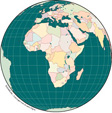|
George Blockley
George Blockley lived and worked with the trader George Westbeech, both as his partner and a manager of Westbeech’s affairs at Pandamatenga south of the Chobe-Zambezi
junction (in present-day northern Botswana), south-central Africa and also in Sesheke (now Mwandi between Kazungula and present-day Sesheke in southwestern Zambia), a royal
capital of the Lozi Litungas (kings) Sipopa, Mwanawina II and Lubosi-Lewanika – in the 1870s and 1880s.
Blockley went to the Zambezi with Westbeech in 1871 and was to become Westbeech’s longest serving employee, probably managing his affairs at both Pandamatenga and Sesheke
(Mwandi). Sampson (2008) claims that Blockley was a man of little education on account of spelling mistakes observed in letters he sent. That said, he was clearly, like
Westbeech himself, a friendly and cheerful man who interacted well and was respected by his African hosts as well as by a range of European travellers who passed through the
area during this era.
The Lozi gave Blockley the name of Georos Maniniana meaning ‘Little George’ to distinguish him from George Westbeech who became known as Georos Umutunya or “Great George.”
Georos was the nearest the Barotse could get to pronouncing the name George.
Much is made of the reluctance of Westbeech to support the Jesuit party to succeed in establishing a mission station among the Barotse whilst allowing them to build a
station at Pandamatenga after their arrival there in June 1880 Blockley was with Westbeech to welcome the Jesuits and it was Blockley who was to be their guide in place of
a certain Walsh who had been badly injured in a wagon accident. It was observed at this time that Blockley was married to a Batoka woman and was fluent in Sikololo.
The Czech explorer and ethnographer, Emil Holub, recounts meeting Blockley upon his arrival at Pandamatenga in 1875 and was shepherded to Sesheke by Blockley who had already
spent several months there managing Westbeech’s affairs in the latter’s absence. The two left Pandamatenga on 3 August 1875, reaching the Chobe on 9 August and ten days later
arriving in Sesheke. The very fact that Holub could cross the Zambezi to the north side and travel unhindered to Sesheke with Blockley is explained by the advance information
from a missionary in Shoshong, that Westbeech had of Holub’s arrival and his reporting of this information to Sipopa who granted permission for a visit, probably on account
of Holub being a ‘nyaka’ or doctor and pestered both Westbeech and Blockley for news of Holub’s arrival.
Blockley died of chest complaint in June 1887 after having been nursed through a bad spate of the fever and rheumatism by Westbeech a year before his own demise.
Reflections
So what are we to make of George Blockley and his sixteen odd years at the Zambezi? Clearly, like Westbeech, he endeared himself to local people, in particular, the Lozi
elites. This would be on account of the way he conducted himself. Unlike so many other European interlocutors with the area and its peoples during his era, Blockley, like
Westbeech, learned Silozi, took a local woman as wife (Westbeech never actually ‘married’ any of his African lovers). Blockley also evidently possessed a friendly, outgoing
manner and did not display arrogance. Blockley helped to establish a presence and trading relationship for traders and hunters from the south and the Peoples of the Upper
Zambezi Valley.
| 










